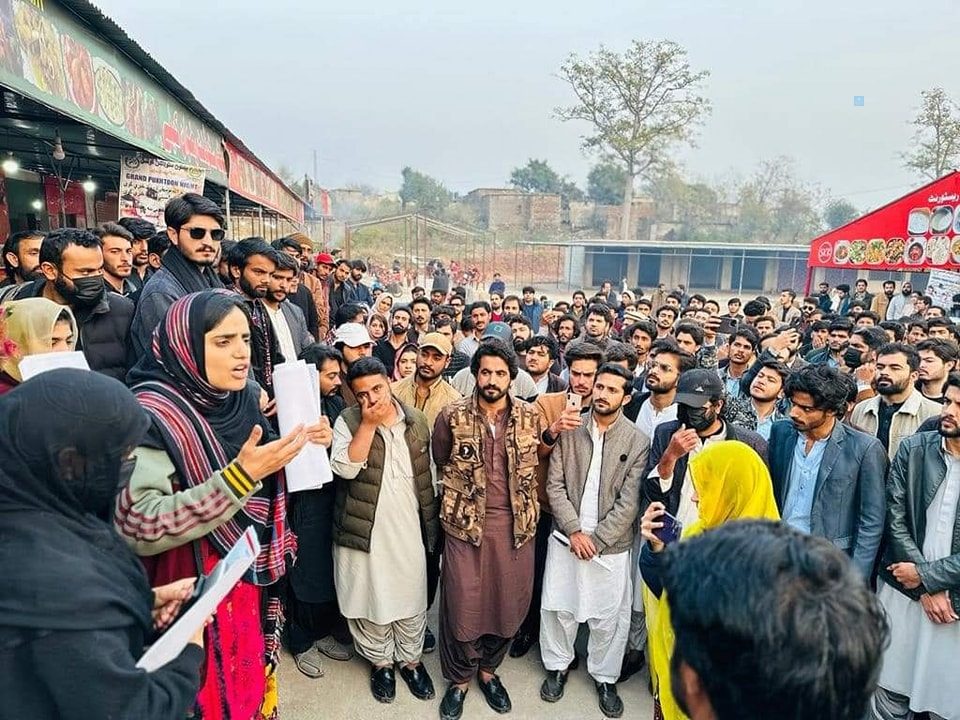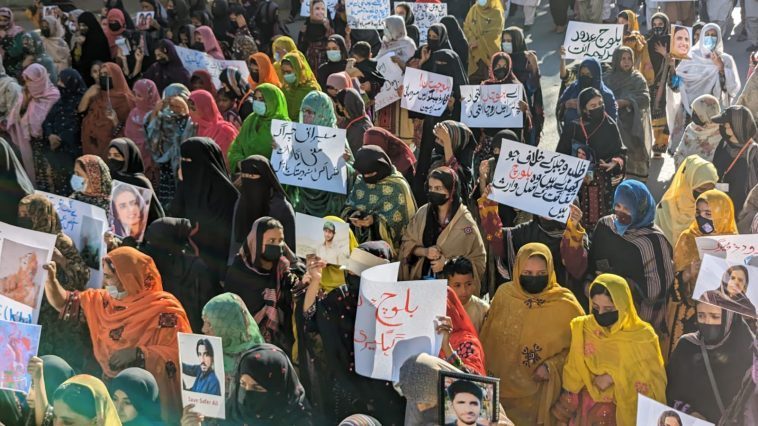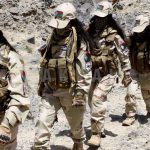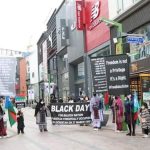When I’d visit my village in Balochistan during Eid or summer holidays, I’d often hear women talk about raids that had occurred in neighbouring villages. The story was always the same: someone was whisked away, allegedly by security forces. Once, I remember hearing about a family whose son joined the insurgency. During a raid, almost all the family’s men were killed.
In these gatherings of women, I’d also hear about the ‘sarmachars’ – a Balochi word used for freedom fighters.
Embroiled in decades of insurgency, Balochistan is home to thousands of victims of enforced disappearances. It is common knowledge that these disappearances are counterinsurgency strategies of the state.
When I started working as a journalist, I focused on enforced disappearances from Balochistan because it felt like a personal responsibility to amplify the voices of the women who were always protesting on the roads. Prior to the recent protest march led by Mahrang Baloch, my reporting had included remote interviews on calls, or at maximum, visiting a protest rally during Eid for a few hours.
‘I AM A JOURNALIST HERE TO COVER THE PROTEST’ –
I found myself repeating this statement on December 21, 2023 as I was being arrested in Islamabad, alongside more than 50 other Baloch women and children. They were all part of the Mahrang led march.
At midnight, when the police decided to crackdown on the peaceful protestors, I could have sidelined myself and walked away. However, witnessing the wrath of the police officers as they ran in with batons and surrounded Baloch protestors from all four sides of the camp, I disregarded my personal safety. Instead of turning away, I kept asking them – “why are you doing this?” – as they shoved everyone. Among them was the father of Balaach Mola Bakhsh, whose custodial killing in Turbat by the Counter Terrorism Department (CTD) had sparked widespread protests in Balochistan that took the shape of this protest march to Islamabad.
Everything turned chaotic in no time. Before I could make sense of what was happening, I felt a push and was dragged by female police officers. I did not realise I was being arrested until I was in the prisoner van.
Inside the van, there were women who had been arrested upon entering Islamabad. At Tarnol, the marchers had been blocked from proceeding to the National Press Club.
One protester started crying as she argued with the female officers. “One of your male officers hurled abuses at me,” she screamed.
It was evident that the people she was arguing with lacked not only empathy but also the power to do anything except following orders.
None of the police officers were aware of the situation. Several conversations showed their confusion: who were these protestors, and why had they come to Islamabad to protest? All they knew was that they had orders to arrest protestors.
Once inside the prison, I kept wondering if I should fight my case further and tell the police officers again that I was not a protester but a journalist.
But something about Bibi Zargul kept me quiet.
She was one of the protesters whose son Saeed Ahmed, a levies officer, has been missing since 2013. She held my hand and repeatedly asked me to stay. I was there to report the protest and not to join the protest. But at that moment, the line blurred for me. My duty to just cover the protest and not be one of the protestors – this contradiction stopped bothering me.
Gradually, more women were brought in from other police stations. As I sat there, with my feet tucked in a cramped space, I felt a shared pain. A deep bond was created between these women because of a common cause. It was palpable.

WHEN THE LINES GET BLURRED
As the day went on, I kept asking the police officers if I could make a phone call. I also started telling them more blatantly that I was a journalist. It did not make a difference. Only after the government’s negotiation team arrived during the evening were our cellphones returned.
I thought all of us would be released. However, it soon became clear that the rest of the women would be forced into buses back to Quetta. Aware of their imminent ‘deportation’, many protestors refused to leave their cells and began to broadcast their plight on social media.
Meanwhile, my friends arrived at the police station to collect me. As I went home, it almost felt like a betrayal as I watched the police forcibly drag screaming women out of sight.
I was angry and enraged as a Baloch, as a woman and as a human. However, I knew I could make a difference as a journalist – by reporting, by tweeting and by talking about what was going on.
For the next month, I continued covering the sit-in camp that was set up outside the National Press Club building in Islamabad. I had written about enforced disappearances before but this time around, it felt personal.
On the days I could not visit the camp, Bibi would call and ask where I was and when I would come. She had started calling me her ‘saathi’ and daughter. This new bond kept me going.
From being tear-gassed along with the protestors, witnessing the police baton-charging students and then spending time in a cell with almost 50 other Baloch women and children, I got a glimpse of how difficult it is for Baloch journalists to report from and on Balochistan, particularly on the issue of enforced disappearances.
Protests against enforced disappearances, extrajudicial killings, and other human rights violations in Balochistan are not a new phenomenon, though they are seldom reported in Pakistan’s mainstream media. Balochistan is a dangerous topic to cover. In 2023, Pakistan was ranked 150th on press freedom worldwide by Reporters Without Borders.
A GRAVEYARD FOR JOURNALISTS
“Balochistan is a conflict zone. There are two forces, the state and the Baloch insurgents and they have been fighting each other for quite a long time. Journalists have become sandwiched between them,” said Akbar Notezai, a journalist from Balochistan working for Dawn News.
“Anyone who tries to do critical stories has to be wary of the consequences. We have to assess whether a story will put us in trouble or not,” he added.
According to Baloch Union of Journalists, more than 40 journalists have been killed in the last 16 years. Amnesty International described Khuzdar town in Balochistan, as a “graveyard for journalists” – a phrase that actually fits for all of Balochistan.
“There is no freedom of press in Balochistan. A Baloch journalist doesn’t have the freedom to write what they witness on ground,” says Naimat Haider, the editor of Balochistan Times, “Journalists from Balochistan have either ended up self-censoring or have fled the country.”
“I was not able to report on many issues that I wanted to because of the fear, even when I had an opportunity to write for a reputable newspaper. The fear caused me to self-censor,” Naimat shared. Haider had to seek asylum in Europe.
Haider also narrated the story of his former colleague, Sajid Hussain, who he regards as one of the best journalists from Balochistan. “He had to leave the country because of his extensive reporting of enforced disappearances and his investigations of Imam Bheel, a drug lord.” A few years later, Sajid was found dead in a river on the outskirts of Uppsala in Sweden.
Haider is wary that the stories from Balochistan do not get space in mainstream national media. He pointed to the recent public gathering when tens of thousands of people from all around the province had gathered in Quetta on the call of Baloch Yakjehti Committee (BYC) after the month-long sit-in in Islamabad had ended.
“This was historic, one of the largest gatherings in the recent history of Balochistan. People joined despite section 144 being imposed, yet it didn’t get any coverage on TV channels.”
Journalists have to risk their life to perform their professional duties. The situation is even more difficult for female journalists as they have to fight an additional battle with the society that does not allow women to perform public functions.
Naeema Zehri of a tribal village in Khuzdar district was brave enough to make the bold decision of using her camera to report ground realities of Balochistan.
“There are next to zero opportunities here for journalists, especially for women,” Zehri told Lok Sujag. Yet she believes it is essential for Baloch women to step into this profession because “issues of women of Balochistan can only be reported by women journalists.”
She visited the Baloch protest camp in Islamabad where another camp was also set up by what was named Baloch Shuhada Forum. It was widely believed that the ‘counter-camp’ put up next to Mahrang’s was meant to sabotage the original protest.
“I had no intentions to visit the other camp but when I was interviewing Baloch mothers, I heard loud noises from the adjacent camp so I decided to go there too,” she told Lok Sujag. “When there I asked a few questions about death squads in Balochistan. I was threatened and told I would be shot if I continued being active. I then was trolled online and fake accounts of mine were created on social media. I had to verify my Twitter (X) handle.”
THE ROLE OF NEW MEDIA
Mahrang Baloch, who led the protest march to Islamabad, believes that the media coverage of the march was limited and biased.
“This is not what a historic protest by thousands of Baloch women deserved,” she asserted.
Talking to Lok Sujag, she elaborates:
“The media’s role should be unbiased. But when it comes to Balochistan, the media often acts as a puppet of the state, propagating state narrative and avoiding interaction with actual victims of state repression.”
The BYC media team filled in for the lack of media coverage by populating social media with live reports and videos from the march, claims Dr. Mahrang Baloch:
“[The media team] faced internet problems when the march was proceeding. It became more challenging to keep social media handles updated as they were being repeatedly reported and blocked. Despite all this, the team came up with ideas to campaign efficiently, producing documentaries and a booklet.”
With Balochistan remaining an “information blackhole” as mainstream media rarely gives coverage to the province, social media and alternative media has played a vital role in bringing the human rights situation from the troubled region into the spotlight. Dr. Mahrang alleges that BYC’s media team was repeatedly harassed, with their masks snatched off to forcibly reveal their identities. Yet, they remained resolute in their reporting.
“Social media was our biggest tool from the start till the end. We challenged the state narrative so much so that the state was compelled to launch a smear campaign. Yet, we were able to globalise our cause and create awareness.”
Somaiyah Hafeez is a journalist focused on human rights, society, climate and politics. Her work has been published in The Guardian, The Diplomat, DAWN, New Lines Magazine and The New Humanitarian, amongst other national and international news organizations.
Section 144 & A Gathering Of Women: Personal Reflections From A Baloch Journalist | Lok Sujag





Comments